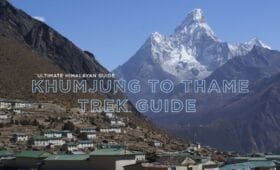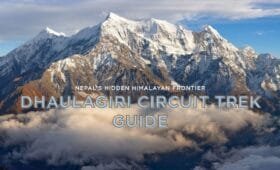The Khumjung Valley Trek is a transformative journey that offers trekkers an authentic glimpse into Nepal’s rich cultural heritage and stunning natural beauty. Also known as the Khumjung Village Trek, this trek takes you through charming Sherpa villages, rugged trails, and serene landscapes in the heart of the Everest region. If you’re seeking a moderately challenging adventure with deep cultural immersion, our comprehensive guide to the Khumjung Valley Trek Itinerary is the perfect starting point. In this article, we will guide you through every aspect of this trek—from detailed itineraries and cost estimates to difficulty ratings, route maps, permits, weather considerations, accommodations, and packing lists—while sharing inspiring testimonials and actionable insights.
Whether you are a first-time trekker or a seasoned adventurer, the Khumjung Valley Trek offers a unique opportunity to experience the essence of Himalayan life without the extreme altitudes of Everest Base Camp. Additionally, by joining this trek through Volunteers Initiative Nepal (ViN), your adventure can create a double impact by supporting community empowerment initiatives in remote Nepal. Let’s dive into the ultimate guide for the Khumjung Valley Trek.
1. Introduction: Discover the Magic of the Khumjung Valley Trek
The Khumjung Valley Trek blends breathtaking mountain scenery with a rich tapestry of Sherpa culture. Starting in the vibrant villages of Khumjung and venturing through terraced fields and ancient trails, this trek offers an unparalleled opportunity to explore one of Nepal’s most culturally vibrant regions.
Many travelers choose the Khumjung Village Trek because it offers an immersive experience without the extreme altitudes encountered on more famous routes like Everest Base Camp. With a well-planned Khumjung Trek Itinerary, trekkers enjoy moderate hikes, stunning panoramas, and the warm hospitality of local communities.
“The Khumjung Valley Trek opened my eyes to the real Nepal—its rugged beauty, the charm of its villages, and the warmth of the Sherpa people. Every step was filled with wonder and genuine connection,” says Tenzin, a seasoned trekker from Bhutan.
The trek provides a physical challenge as well as a cultural journey. It perfectly blends adventure and tradition, where modern trekking meets centuries-old practices. This article is designed to guide you through every detail of the trek and help you prepare for an unforgettable Himalayan experience.
2. The Cultural and Natural Tapestry of Khumjung Valley
2.1 Rich Sherpa Heritage
The Khumjung Valley Trek offers a deep dive into the Sherpa way of life. The heart of Sherpa culture, Khumjung, is renowned for its historical significance, including the famous Khumjung Buddha statue gifted by Tenzing Norgay. The village is a vibrant center of traditional Sherpa customs, where ancient monasteries, prayer flags, and traditional festivals coexist with modern amenities.
Trekking through Khumjung allows you to witness firsthand the resilience and hospitality of the Sherpa people. Their age-old traditions and warm welcome enrich your trekking experience, making the journey a physical endeavor and a soulful exploration of cultural heritage.
2.2 The Natural Splendor
The natural beauty along the Khumjung Valley Trek is equally captivating. As you traverse the valley, you’ll encounter a mosaic of landscapes—from lush forests and terraced farmlands to rugged mountain trails and panoramic vistas. The trail meanders along the base of towering peaks, offering breathtaking views of the Himalayas.
Local flora and fauna add to the allure, with rhododendron forests that burst into color during spring and autumn. The interplay between nature and culture creates a dynamic backdrop for this trek, where every step is a discovery.
“Every time I looked up, the mountains told a story. The lush valleys and the serene pace of life in Khumjung left an indelible mark on my soul,” remarks Sarah, an enthusiastic trekker from the United Kingdom.
Itinerary
3. Detailed Itinerary: Your Khumjung Valley Trek Itinerary
A well-structured Khumjung Trek Itinerary is essential for maximizing your experience while ensuring proper acclimatization. Below is a sample 8-day itinerary that blends trekking, cultural exploration, and sufficient rest.
Day 1: Arrival in Kathmandu
- Activities: Land in Kathmandu, transfer to your hotel in Thamel, and attend an orientation session.
- Highlights: Explore local markets and historic sites like Durbar Square.
- Overnight: Hotel in Kathmandu.
Day 2: Kathmandu to Lukla, then Trek to Phakding
- Transport: Early morning flight from Kathmandu to Lukla (~2,840m).
- Trekking: Hike from Lukla to Phakding (~3-4 hours) along the Dudh Koshi River.
- Highlights: Scenic suspension bridges, lush landscapes.
- Overnight: Teahouse in Phakding (~2,610m).
Day 3: Phakding to Namche Bazaar
- Trekking Duration: 5–6 hours.
- Route: Ascend gradually, crossing multiple suspension bridges.
- Highlights: The first encounter with Sherpa culture and bustling local markets.
- Overnight: Teahouse in Namche Bazaar (~3,440m).
Day 4: Acclimatization in Namche Bazaar
- Activities: Optional hike to Everest View Hotel or local museum visit.
- Purpose: Essential for acclimatization and adjustment to higher altitudes.
- Overnight: Teahouse in Namche.
Day 5: Namche Bazaar to Khumjung
- Trekking Duration: 4–5 hours.
- Route: Trek from Namche to Khumjung, enjoying scenic views and interacting with locals.
- Highlights: Visit Khumjung School and the famous Buddha statue.
- Overnight: Teahouse in Khumjung (~3,440m).
Day 6: Khumjung to Thame
- Trekking Duration: 4–5 hours.
- Route: A gentle yet steady ascent leading to Thame.
- Highlights: Rich Tibetan Buddhist heritage, ancient monasteries.
- Overnight: Teahouse in Thame (~3,600m).
Day 7: Exploring Thame
- Activities: Explore culturally in Thame, visit local monasteries, engage in prayer sessions, and enjoy traditional Sherpa hospitality.
- Highlights: Deep cultural immersion and learning local traditions.
- Overnight: Teahouse in Thame.
Day 8: Return Journey from Thame to Khumjung and Back to Lukla
- Trekking Duration: 6–7 hours.
- Route: Retrace your steps from Thame to Khumjung, then descend to Lukla.
- Overnight: Teahouse in Lukla.
Day 9: Lukla to Kathmandu
- Transport: Morning flight from Lukla back to Kathmandu.
- Activities: Debrief in Kathmandu and do the final souvenir shopping.
- Overnight: Hotel in Kathmandu.
This Khumjung Trek Itinerary offers flexibility for trekkers, allowing adjustments based on fitness levels and weather conditions. It emphasizes proper acclimatization, cultural exploration, and scenic enjoyment at every step.
4. Trek Route and Distance Overview
The Khumjung to Thame Trek Distance is relatively short compared to other high-altitude treks in Nepal but rich in cultural and natural beauty. The route covers approximately 20–25 km one-way, making the round-trip distance roughly 40–50 km. Despite the shorter distance, the continuous ascent and descent add to the physical challenge, and the diverse landscapes create a dynamic trekking experience.
Key Segments of the Trek:
- Khumjung Village: A historic Sherpa settlement known for its cultural heritage and landmarks like the Buddha statue.
- Midway Routes: Scenic trails that pass through terraced fields, ancient monasteries, and quiet rural villages.
- Thame Village: The destination and charities are prized for their Tibetan Buddhist heritage and tranquil environment.
- Return Route: Retracing the steps provides a chance to absorb the changing landscapes from a fresh perspective.
Using a detailed Khumjung Trek Map is essential for navigation. Local trekking agencies provide maps that mark teahouse locations, elevation changes, and critical trail junctions, ensuring a smooth journey even in remote areas.
5. Assessing Trek Difficulty and Altitude
The Khumjung Valley Trek is considered moderately challenging, making it accessible to a wide range of trekkers. However, the Khumjung Trek Difficulty is influenced by several factors:
- Elevation: Khumjung is around 3,440m, and Thame is about 3,600m. While these altitudes are not extreme compared to Everest Base Camp, altitude sickness can still occur, so proper acclimatization is key.
- Terrain: The route features a mix of well-trodden paths, steep ascents, and uneven, rocky sections.
- Daily Duration: Trekkers can expect to walk 4–6 hours daily. Though the distance is moderate, the physical exertion required, particularly on steep sections, should not be underestimated.
- Weather Conditions: Variable weather along the trek can add to the challenge, especially during transitional seasons.
For most trekkers, the Khumjung Valley Trek offers a balanced challenge. Beginners should consider hiring a Khumjung Trek Guide to gain local insights, ensure safe navigation, and provide support during the acclimatization phases.
6. Budgeting and Cost Considerations
One of the attractive aspects of the Khumjung Valley Trek is its affordability. The Khumjung Trek Cost varies based on your personal preferences, but here’s a general breakdown:
Cost Components:
- Transportation:
- Kathmandu to Lukla: A flight from Kathmandu to Lukla costs approximately USD 180–200 each way.
- Local Transport: Buses or shared jeeps for transfers between trekking points are economical.
- Accommodation and Meals:
- Teahouse Lodging: Basic teahouse rates typically range from USD 3–6 per night in lower altitudes and around USD 5–8 at higher elevations.
- Meals: Daily costs average USD 20–30, with prices increasing at higher altitudes.
- Permits and Fees:
- Local Permits: Some local municipality fees may apply (around USD 20).
- TIMS Card: Approximately USD 10–20 if your trek intersects protected areas.
- Guide and Porter:
- Guide Fees: Hiring a Khumjung Trek Guide is optional but recommended, costing roughly USD 25–30 per day.
- Porter Fees: Approximately USD 15–20 per day if you require assistance with heavy luggage.
- Miscellaneous:
- Additional expenses include hot showers, Wi-Fi (typically USD 2–5 per day), and gear rentals if necessary.
For a 7–9 day trek, budget travelers can expect to spend between USD 300 and 600, while a guided package with added amenities might range from USD 500 to 800. These costs make the Khumjung Valley Trek one of the most accessible Himalayan treks for those looking to balance adventure with affordability.
7. Permits and Documentation
While the Khumjung Valley Trek is less bureaucratic than higher Himalayan treks, a few permits and documents are necessary:
- Local Municipality Permits: Some regions within the valley may require a small permit fee, generally around USD 20.
- TIMS Card: Although not always required for lower-altitude treks, obtaining a TIMS card (USD 10–20) is advisable to extend your journey into other protected areas.
- Identification: Always carry your passport and copies of all permits and travel insurance. Checkpoints or local authorities might request these documents.
Verify permit requirements with your Khumjung Trek Guide or local trekking agency before departure to ensure a hassle-free experience.
8. Weather Conditions and Best Time to Trek
8.1 Best Time for the Trek
The Khumjung Valley Trek Best Time is during the autumn (September to November) and spring (March to May) seasons:
- Autumn: This season is popular due to clear skies, stable weather, and vibrant autumn colors. Days are crisp, and nights are cold but manageable.
- Spring: Characterized by blooming rhododendrons, moderate temperatures, and refreshing green landscapes. Occasional showers may occur, but the overall conditions remain pleasant.
- Winter: Fewer trekkers and clear skies make winter an option for those who can handle the cold. However, nights can be freezing.
- Monsoon: The monsoon season (June to August) brings heavy rainfall, slippery trails, and potential travel disruptions, making it the least favorable time to trek.
8.2 Weather and Altitude
The Khumjung Trek Weather can change rapidly. At Khumjung (~3,440m) and Thame (~3,600m), expect:
- Daytime: Moderate temperatures, typically ranging from 10°C to 15°C during autumn and spring.
- Nighttime: Cooler temperatures that may drop close to freezing.
- Rainfall: Minimal in autumn and spring; more frequent during the monsoon.
Understanding these conditions is key to preparing the appropriate gear and planning your daily pace.
9. Accommodation Options Along the Route
The Khumjung Trek Accommodation experience varies along the trek. Most travelers can expect basic yet hospitable teahouse lodging:
- Khumjung Village: Offers simple teahouses with shared or private rooms, communal dining, and basic amenities.
- Thame Village: Typically, accommodations are more rustic, reflecting the remote nature of the village. However, the warmth of local hospitality compensates for any lack of luxury.
- Overall: Modest facilities provide essential comforts after a long day on the trail. Prices are affordable and vary from USD 3–8 per night, with additional charges for services such as hot showers or Wi-Fi.
This traditional lodging is an integral part of the cultural experience of the Khumjung Valley Trek, connecting you with local ways of life and the enduring spirit of the Sherpa community.
Trekking Tips and Packing List
10. Essential Trekking Tips and Packing List
10.1 Must-Have Items for Your Trek
A comprehensive Khumjung Trek Packing List is essential for a comfortable and safe adventure. Here are the key items:
- Clothing:
- Thermal base layers and moisture-wicking shirts.
- A warm fleece or down jacket.
- Waterproof and windproof outer shell.
- Trekking pants and shorts.
- A warm hat, gloves, and a neck gaiter.
- Footwear:
- Sturdy, well-broken-in trekking boots.
- Trekking socks (multiple pairs) and gaiters.
- Accessories:
- Trekking poles to ease the strain on steep ascents and descents.
- Sunglasses, sun hat, and high-SPF sunscreen.
- A buff or scarf.
- Backpack:
- A daypack (25-35L) to carry essentials.
- Hydration:
- Reusable water bottles or a hydration system.
- Water purification tablets or a portable filter.
- Gear:
- A headlamp with extra batteries.
- Camera with extra memory cards.
- A power bank and charging cables.
- A compact first-aid kit and personal medications.
- Documentation:
- Passport, necessary permits, TIMS card, travel insurance, and copies of all essential documents.
- Miscellaneous:
- Energy bars, nuts, and snacks.
- A lightweight travel journal and pen.
- Extra cash in local currency for teahouse tips and incidental expenses.
10.2 Additional Trekking Tips
- Acclimatization: Although the altitudes in this trek are moderate, proper acclimatization is crucial. Rest if you experience any symptoms of altitude sickness.
- Hydration: Drinking at least 3 liters of water daily is recommended, especially during strenuous climbs.
- Pace Yourself: Maintain a steady pace and use trekking poles to minimize joint strain.
- Respect Local Culture: Greet everyone with “Namaste” and ask permission before photographing local people or sacred sites.
- Prepare for Weather Changes: Layer your clothing and always carry a waterproof jacket, as Himalayan weather can be unpredictable.
- Book Accommodations in Advance: During peak trekking seasons, teahouses may fill up quickly, so it is advisable to book in advance.
- Monitor Your Health: Keep a basic first-aid kit handy and consider altitude medication if you are prone to symptoms.
FAQs
11. Seven Frequently Asked Questions
What is the total distance of the Khumjung Valley Trek?
The Khumjung Valley Trek Distance is approximately 40–50 km round-trip, depending on the route and detours.
How difficult is the Khumjung Valley Trek?
The Khumjung Trek Difficulty is generally moderate. While the elevation is manageable, the continuous ascent and descent over uneven terrain require good physical fitness.
How long does the trek typically last?
The typical Khumjung Trek Duration is 7–9 days, allowing sufficient time for acclimatization and cultural exploration.
What is the average cost of the trek?
The Khumjung Trek Cost generally ranges from USD 300–600 for a budget-friendly trek using teahouse accommodations. Guided packages can range from USD 500–800.
Which permits are required for this trek?
Permits may include local municipality fees and a TIMS card (approximately USD 10–20). Always check current requirements with your Khumjung Trek Guide.
What is the best time to undertake the trek?
The Khumjung Trek’s Best Time is during autumn (September–November) or spring (March) when weather conditions are optimal and scenic views are at their best.
Do I need a guide for this trek?
While the Khumjung Valley Trek is relatively straightforward, hiring a Khumjung Trek Guide (around USD 25–30 per day) is recommended for safety, local insights, and logistical support.
Conclusion
The Khumjung Valley Trek offers an extraordinary Himalayan adventure that marries stunning natural beauty with a deep immersion in Sherpa culture. As you traverse the scenic trails from Khumjung to Thame, you will experience the authenticity of Nepal’s rural heartland, enjoy breathtaking views of the surrounding peaks, and engage with communities steeped in tradition and warmth.
This trek is more than a physical journey; it is a cultural pilgrimage that allows you to explore the region’s rich heritage, from ancient monasteries to vibrant local markets. With its moderate difficulty, manageable distance, and well-defined itinerary, the Khumjung Valley Trek is an ideal adventure for novice and experienced trekkers.
By choosing to embark on this trek with Volunteers Initiative Nepal (ViN), you will fulfill your quest for adventure and contribute to community empowerment. ViN organizes charity trekking and travel tours, where every step you take helps fund vital projects in education, healthcare, and sustainable development in remote Nepali communities. Your adventure will make a double impact, nourishing your spirit while uplifting the lives of local people.
- Volunteer: Lend your time and skills to support local community projects in Nepal.
- Intern: Gain hands-on experience in a life-changing cultural and trekking adventure.
- Donate: Your contributions help fund essential projects that empower remote communities.
- Share: Encourage friends, family, and colleagues to join this transformative journey and support sustainable tourism.
Namaste—let your journey through the Kathmandu Valley and beyond be a source of inspiration, cultural exchange, and lasting impact.




